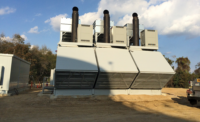The $380-million project at Stanford University includes high-efficiency new-building standards and improvements to existing buildings, a high-voltage substation, state-of-the-art solar arrays and a new central energy facility (CUP) that incorporates the largest heat-recovery chillers ever installed in the U.S., according to the project team.
The CUP circulates hot water to heat buildings and cold water to cool them, each in a closed loop so the water won’t need constant replacement. The cold water gradually heats as it travels through the campus, returning to the CUP 14 degrees warmer than when it left. Equipment within the facility strips that heat from the cold water pipes and adds it to the hot water pipes.
“SESI uses a combination of heat recovery, low-temperature hot water distribution and thermal-energy storage to reduce campus greenhouse gas emissions by 68% and drinking water use by 15%,” says Damon Ellis, vice president for the project’s general contractor, Whiting-Turner.
Completed on time in March and on budget, the project team says it fostered a collaborative design-assist and design-build environment.
Crews placed, welded, insulated and backfilled 20 miles of underground hot water distribution piping. Ultrasonic testing verified 4,000 welds, and pipes also underwent hydro-testing.
In addition, a total of 130 Stanford campus buildings were converted from steam to more energy efficient hot water. More than 40 concurrent running jobsites and 30 to 40 utility shutdowns occurred weekly for 14 months without unplanned utility outages. Construction also did not impact adjacent pedestrian and bicycle traffic on the active campus.
Major challenges were presented by the district heating controls, metering and heat exchanger optimization, as these were the first of their kind in the U.S., says the submitter.
The team designed a standardized heat exchanger skid, with only the capacities varying by building. “This allowed the long lead equipment to be ordered directly by Whiting-Turner before the mechanical subcontractors were hired. The prefabrication allowed building shutdowns to be much shorter, with less disruption to research and building occupants,” Ellis says.
For Stanford’s operations and maintenance staff, the equipment standardization made training consistent while the different departments shared lessons learned.
“Knowing that the central energy facility would become a centerpiece of learning for students, industries, engineers, trades and other professionals, the team understood that quality means conformance to plans and specifications and performance criteria, and nothing less. The team created an atmosphere where individuals made quality performance a personal goal,” Ellis says.
Stanford Energy System Innovation (SESI)
Stanford
Key Players
Owner Stanford University
Lead Design Firm Affiliated Engineers Inc.
Architect ZGF Architects
Contractor Whiting-Turner
Structural Engineer Rutherford + Chekene
Civil Engineer BKF Engineers
MEP Engineer ACCO Engineered Systems
Geotechnical Engineer Cornerstone Earth Group






Post a comment to this article
Report Abusive Comment